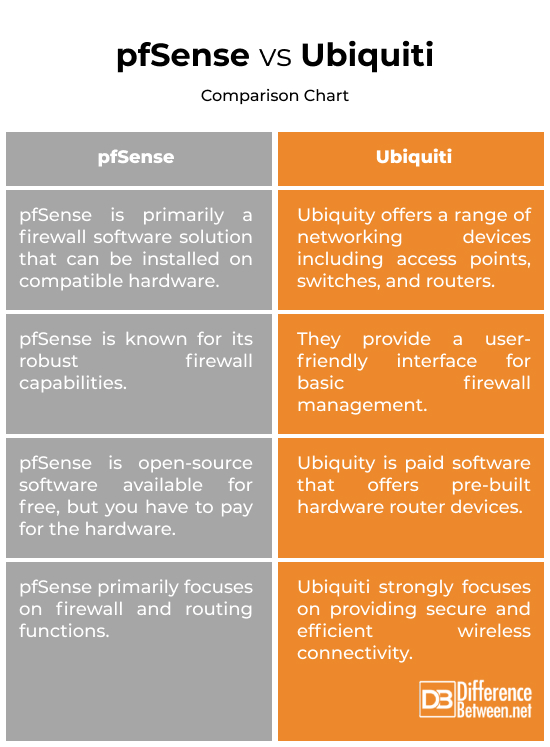Difference Between pfSense and Ubiquiti
In today’s ever-changing digital landscape, network security is very important for businesses and organizations. Protecting inbound and outbound connections is paramount to ensure the safety of data. When it comes to modern networking, pfSense and Ubiquiti play crucial roles in addressing different aspects of network management and security. Although they are used for different purposes, both offer different levels of cybersecurity. Both are reliable, cost-effective solutions for building and managing networks of various sizes and complexities. In this article, we look at the key differences between pfSense and Ubiquiti.

pfSense
pfSense is a powerful, open-source firewall and router software based on FreeBSD. It’s designed to provide advanced networking and security features, suitable for both homes and businesses. With a web-based interface, users can easily manage and configure firewall rules, VPNs, QoS, and more. It also supports features like intrusion detection and prevention, content filtering, and load balancing.

Ubiquiti
Ubiquiti is a tech company specializing in networking products. Their UniFi line includes access points, switches, routers, cameras, and other network equipment. These products are designed to provide reliable and scalable network solutions with a focus on centralized management through their UniFi Controller software. They are used by individuals, businesses, and service providers looking for cost-effective yet high-performance networking solutions.
Difference between pfSense and Ubiquiti
Deployment
– pfSense is primarily a firewall software solution that can be installed on compatible hardware, such as dedicated appliances or virtual machines. It is firewall and router software that can be deployed through the cloud or a network box if you have sensors. pfSense is open-source and trusted by individuals and businesses looking to customize the software based on their performance requirements.
Ubiquiti, on the other hand, is an ecosystem of hardware solutions offering a range of networking devices, including access points, switches, and routers. These devices are designed to seamlessly integrate into existing network setups to provide a cohesive and standardized networking ecosystem.
Firewall
– Although designed for different purposes, pfSense and Ubiquiti can both be used as firewall solutions. pfSense is known for its robust firewall capabilities. It offers intricate control over firewall rules and allows users to fine-tune traffic filtering, port forwarding, and deep packet inspection. It is perfect for complex network configurations and security infrastructure.
Ubiquiti devices also include firewall functionality, but their focus is more streamlined. They provide a user-friendly interface for basic firewall management and cater to users looking for straightforward security setup without needing advanced rule customization.
Wireless and Security
– pfSense primarily focuses on firewall and routing functions, but it can integrate into wireless access points to create secure wireless networks. However, its wireless capabilities may not be as comprehensive as those offered by specialized wireless networking solutions.
Ubiquiti’s UniFi line prominently includes wireless access points with robust security features. These access points can be easily managed through the UniFi Controller software, allowing for seamless deployment and monitoring of wireless networks. Ubiquiti strongly focuses on providing secure and efficient wireless connectivity.
Centralized Management
– pfSense is an all-in-one solution that allows users to customize or implement just about anything. Its centralized management features are more focused on network-related functions such as firewall rules, VPNs, and routing. It may require additional tools for comprehensive centralized network management.
Centralized management is at the heart of Ubiquiti’s UniFi ecosystem. The UniFi Controller software provides a centralized dashboard to manage and monitor various networking devices, including access points, switches, and security cameras.
pfSense vs. Ubiquiti: Comparison Chart

Summary
Overall, pfSense offers a more cost-effective solution in terms of software as it is open-source, but users need to consider hardware costs and optional subscription fees. pfSense is a better option for businesses or organizations with a broader range of network security needs. Ubiquiti, on the other hand, is easier to use and navigate, which makes it ideal for small to medium businesses with fewer definitive needs for network users. It offers a range of affordable devices that can be managed through the free UniFi Controller software.
FAQs
Is UniFi better than pfSense?
It depends on individual needs and preferences. UniFi is more user-friendly and intuitive than pfSense, but its functionalities are limited. pfSense focuses on advanced security and customization. The choice depends on your priorities and technical requirements.
What are the disadvantages of pfSense?
Some downsides of pfSense include potential complexity for beginners due to advanced features, hardware compatibility concerns, and the need for technical knowledge.
Why is pfSense better?
pfSense is a powerful firewall and router solution that excels in advanced network security, firewall control, and extensive customization. This makes it a solid choice for those looking for powerful network management capabilities.
Why is pfSense better than a router?
pfSense surpasses standard routers in offering advanced security features, deeper customization, and the ability to handle complex network setups effectively.
Should I use pfSense as my router?
Only if you are looking for advanced networking features, and you’ll need the technical know-how for setup and maintenance.
Do I need a router if I have pfSense?
No, pfSense can replace a traditional router with its routing capabilities. However, you might still use additional hardware for Wi-Fi access points or specific functionality.
- Difference Between Caucus and Primary - June 18, 2024
- Difference Between PPO and POS - May 30, 2024
- Difference Between RFID and NFC - May 28, 2024
Search DifferenceBetween.net :
Leave a Response
References :
[0]Enoka, Seth. Cybersecurity for Small Networks: A Guide for the Reasonably Paranoid. California, US: No Starch Press, 2022. Print
[1]Radichel, Teri. “PFSense in Front of UDM. Why?” Medium, 7 Apr. 2022, medium.com/cloud-security/pfsense-in-front-of-a-udm-why-6ff6ec83f5ed.
[2]“pfSense vs. Ubiquiti (Unifi).” WunderTech, 3 Nov. 2022, www.wundertech.net/pfsense-vs-ubiquiti-unifi/.
[3]Image credit: https://www.canva.com/photos/MAE8bzIzMAA-cloud-computing-technology-in-office/
[4]Image credit: https://www.canva.com/photos/MAEuxaFoGME-abstract-digital-global-network-connection-with-binary-code/
